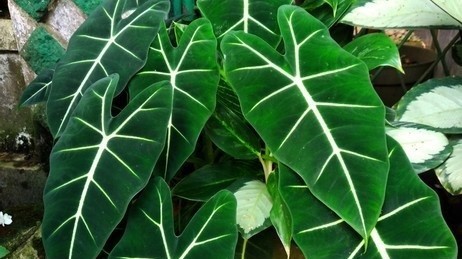Alocasia Plant Tissue Culture
Alocasia is a perennial herb of Araceae, and there are more than 80 known species of Alocasia plants worldwide, mainly in the tropical and subtropical regions of Asia. Alocasia plants like high temperature and humid environment, shade tolerant, intolerant of strong wind and strong light, grow vigorously when planted in pots or buckets, and can create a spectacular tropical landscape.
 The beauty of Alocasia leaves
The beauty of Alocasia leaves
Tissue culture technology can overcome the disadvantages of
traditional methods and has advantages those traditional
methods do not have.
Alocasia plants can be divided into two groups according to their stature and growth habit. One group grows at the edge of the forest floor with tall, erect stems and broad leaves that require more water and light. The other is a group of dwarf plants that grow on the rocky understory and are relatively shade-loving.
Traditional propagation methods
The division method is simple, has a high survival rate, and can be used when the demand is low, but it is difficult to meet the demand for the number of seedlings for large-scale planting in greening projects.
This method is not limited by the season, as long as the temperature and seedbed conditions are properly controlled. Cuttings can be propagated in all seasons. However, the growth period is long and it is not suitable for screening high-quality varieties.
Wild or cultivated Alocasia plants can be propagated by sowing if they have seeds. However, this method limits the cultivation of species with stunted seeds or those that do not germinate easily.
The roots of some Alocasia species will naturally divide into small seed balls that can be separated from the mother plant and sown. However, this method is limited to the use of some varieties and is not suitable for widespread use.
Tissue culture service

Lifeasible uses stem tips, stem segments, terminal buds, lateral buds, and basal bulbous roots as explants in tissue culture, and can also be propagated by generating guaiac tissue from leaves, petioles, roots, and inflorescences, and then inducing adventitious shoots. After sterilizing the explants to obtain sterile material, they are transferred to the multiplication medium to expand the number and then to root culture, after which they are transferred to cavity trays and finally to refine the seedlings in the greenhouse.
You want to sign a confidentiality agreement.
You have a specific plant species for your experimental needs.
You have a reliable and relevant cooperation project to discuss.
You are very interested in our project or have any questions.
You need an updated and detailed quotation.
For research or industrial use.

 The beauty of Alocasia leaves
The beauty of Alocasia leaves

